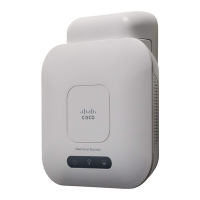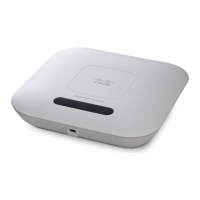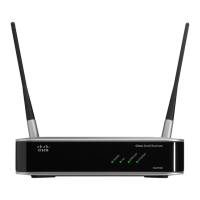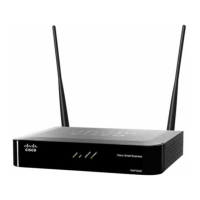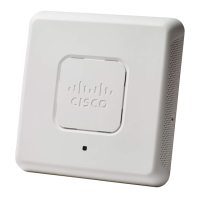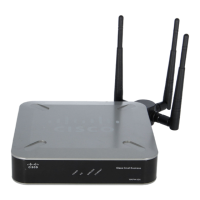Viewing the Rogue AP List
In order for the Rogue AP Detection to function, the wireless radio must be enabled. You should first enable
the radio interface before enabling the Rogue AP detection for the radio interface.
To enable the radio to collect information about rogue APs:
Step 1 Select Security > Rogue AP Detection.
Step 2 Check Enable to enable the AP Detection for Radio 1 and Radio 2.
Step 3 Click Apply.
The Detected Rogue AP List table displays all detected rogue APs. The Trusted AP List displays all trusted APs. The
following settings are displayed for each or the Rogue AP lists:
• MAC Address — The MAC address of the rogue AP.
• Radio — Indicates whether the rogue AP is detected on Radio 1 or Radio 2.
• Beacon Interval (Msec.) — The beacon interval used by the rogue AP. Beacon frames are transmitted by an AP at
regular intervals to announce the existence of the wireless network. The default behavior is to send a beacon frame
once every 100 milliseconds (or 10 per second). The Beacon Interval is set on the Radio, on page 47 page.
• Type — The type of the device. The options are:
• AP — An AP rogue device that supports the IEEE 802.11 Wireless Networking Framework in infrastructure
mode.
• Ad hoc — A rogue station running in Ad hoc mode. The Ad hoc mode is an IEEE 802.11 Wireless Networking
Framework also referred to as peer-to-peer mode or an Independent Basic Service Set (IBSS).
• SSID — The Service Set Identifier (SSID) for the WAP device.
• Privacy — Indicates whether there is any security on the rogue device. The options are:
• Off — Security mode is off (no security).
• On — Security mode is on.
• WPA — Shows whether the WPA security is on or off for the rogue AP.
• Band — The IEEE 802.11 mode being used on the rogue AP, such as IEEE 802.11a, IEEE 802.11b, IEEE 802.11g,
IEEE 802.11n, and IEEE 802.11ac.
The number shown indicates the mode:
• 2.4 indicates IEEE 802.11b, 802.11g, or 802.11n mode (or a combination of the modes).
• 5 indicates IEEE 802.11a, 802.11n, or 802.11ac mode (or a combination of the modes).
• Channel — The channel on which the rogue AP is currently broadcasting.
• Rate — The rate in megabits per second at which the rogue AP is currently transmitting. The current rate is always
one of the rates shown in the Supported Rates field.
• Signal — The strength of the radio signal emitting from the rogue AP. The number representing the strength in
decibels (dB) is displayed on the right side of the bar.
Cisco WAP150 Wireless-AC/N Dual Radio Access Point with PoE / Cisco WAP361 Wireless-AC/N Dual Radio Wall Plate Access Point with PoE
43
System Configuration
Viewing the Rogue AP List
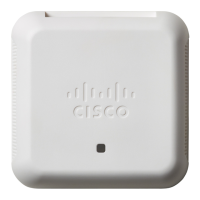
